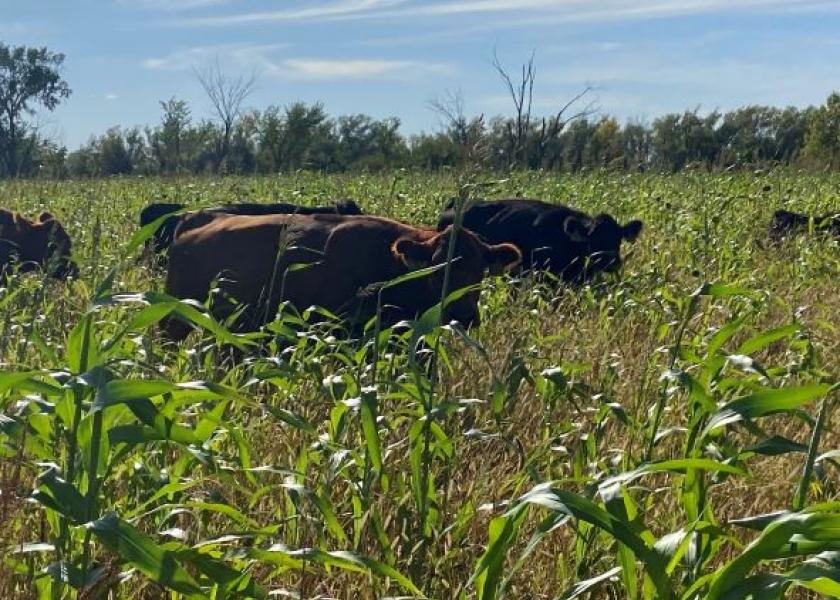Dropping Like Flies-Prussic Acid in Cattle

On Friday Oklahoma State animal scientists said reported several cattle deaths due to prussic acid toxicity in forages in Northwest Oklahoma and the Oklahoma Panhandle. Veterinarians Rosslyn Biggs and Barry Whitworth provide management tips for cattle and pastures when conditions increase the risk of prussic acid poisoning.
As the year progresses many producers look to move cattle to alternative pasture. Unfortunately, certain weather conditions, including drought or frosts, can set up some plants in the sorghum family, including Johnsongrass, to become toxic. Even after limited grazing, deaths may be seen due to the ingestion of prussic acid, also known as hydrocyanic acid or cyanide. A classic call to the veterinarian is, “My cattle are dropping like flies.”
Prussic acid toxin is created when the harmless hydrocyanic glycosides in plants are stressed and breakdown. Once the hydrocyanic glycosides in the plants are damaged through actions like cattle chewing or a swather and crimper, they quickly convert to prussic acid. Following ingestion, the prussic acid is released in the rumen and rapidly absorbed into the blood stream.
Once in the circulatory system, the toxin prevents cells from taking up oxygen. The blood therefore becomes saturated with oxygen leading to blood that appears bright cherry red. The clinical signs most often seen include excitement, muscle tremors, increased respiration rate, excess salivation, staggering, convulsions, and collapse. Asphyxiation at the cellular level is the cause of death due to deprivation of oxygen.
When producers encounter animals displaying clinical signs of prussic acid toxicity, they should immediately remove all the animals that appear normal to a new pasture and contact their veterinarian. The veterinarian will treat the sick animals with two drugs (sodium nitrite and sodium thiosulfate) that can reverse the toxicity. Treatment must be initiated quickly but can prove difficult due to the rapid progression of the toxin.
The drugs used to treat prussic acid toxicity can be difficult to obtain. It is advisable to contact your veterinarian before grazing potential toxic plants to make sure that your veterinarian will have availability to respond and the necessary drugs on hand to treat the cattle if a problem arises.
Cattlemen may want to take the following steps to prevent prussic acid toxicity:
- Never turn hungry cattle into a new pasture
- Take soil samples and fertilize accordingly
- Graze mature plants with 18 to 24 inches of height
- Wait until plants are cured before grazing after frost (usually at least 7 days)
- Rotate pastures to keep cattle from consuming lush regrowth
- Place 1 or 2 cows in a pasture and observe for problems before turning in all the cattle
- Test plants for the presence of prussic acid. Care should be taken though as false negatives can be seen if the test is not performed correctly.
Two types of tests exist for determining prussic acid levels. The first is quantitative and involves submissions to a diagnostic lab, such as the Oklahoma Animal Disease Diagnostic Lab. The second is a qualitative test which simply detects the presence of hydrocyanic acids and cyanide in fresh plant material. Most County Agriculture Extension Educators have access to test supplies.
Producers should be cautious that there are multiple toxins that can cause cattle deaths. It is recommended that appropriate veterinary diagnostics and testing be done to determine the ultimate cause of death. A fact sheet that contains information about prussic acid is available at Prussic Acid Poisoning | Oklahoma State University (okstate.edu).
Dr Glenn Selk OKSTATE Beef Cattle Specialist, explains the risk of prussic acid poisoning from grazing johnsongrass on a classic Cow-Calf Corner on Sunup TV.
https://video.okstate.edu/media/Cow-Calf+CornerA+Prussic+Acid+Poisoning/0_fb75fqy7







